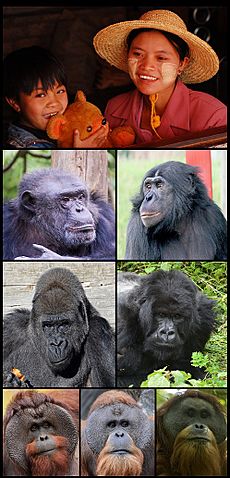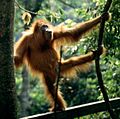Hominidae facts for kids
Quick facts for kids HominidsTemporal range: Miocene to Recent
|
|
|---|---|
 |
|
| The eight living hominidae species | |
| Scientific classification | |
| Kingdom: | |
| Phylum: | |
| Class: | |
| Order: | |
| Superfamily: | |
| Family: |
Hominidae
|
Hominids are a family of animals called Hominidae. This group includes humans, chimpanzees, gorillas, and orangutans. They are often called "great apes." Sometimes, "great ape" means all of them, including humans. Other times, it means all of them except humans. But remember, humans (Homo sapiens) are definitely hominids!
Hominids are Primates, which means they are related to monkeys. But unlike most monkeys, hominids do not have tails. They have strong bodies and well-developed forearms. Their thumbs can touch their other fingers, which helps them grip things. All their fingers and toes have flat nails.
Hominids can weigh from about 48 kilograms (106 pounds) to 270 kilograms (595 pounds). Males are usually larger than females.
Today, there are four main types (genera) and five species of living hominids. The non-human hominids live in rainforests near the equator. You can find them in Africa, Sumatra, and Borneo.
Scientists have also found many fossil hominids. These include the Australopithecines and the genus Homo (which includes humans). The oldest hominid fossils are from the Miocene epoch. They have been found in Asia and Europe. For example, Neanderthals lived in Europe and western Asia for a very long time. This was long before our species, Homo sapiens, appeared. Asia also had a giant orangutan called Gigantopithecus.
Contents
Understanding Hominid Classification
Scientists group living things into families. This helps us understand how different species are related. The way hominids are classified can be a bit tricky. Different scientists sometimes have slightly different ideas.
Here is one common way to classify the great apes:
- Family Hominidae: These are the great apes.
- Subfamily Ponginae
- Genus Pongo – This group includes the orangutans.
- Subfamily Homininae
- Genus Gorilla – This group includes the gorillas.
- Genus Pan – This group includes the chimpanzees.
- Australopithecus† and other extinct relatives – These are ancient human relatives that are no longer alive.
- Genus Homo – This group includes humans.
- Subfamily Ponginae
A More Detailed Look
A more modern way of classifying hominids shows how Australopithecines and humans are different from the apes that live in rainforests. This classification is supported by many important scientific books.
Superfamily Hominoidea (This group includes all apes)
- Family Hylobatidae (These are the gibbons, which are smaller apes)
-
- Genus Hylobates
-
- Family Hominidae (These are the great apes)
- Subfamily Ponginae
- Genus Pongo (Orangutans)
- Subfamily Gorillinae
- Genus Gorilla (Gorillas)
- Subfamily Homininae (This group includes chimpanzees and humans)
- Tribe Panini
- Genus Pan (Chimpanzees)
- Tribe Hominini (This group includes humans and their closest extinct relatives)
- Subtribe Australopithecina (These are early human ancestors)
- Genus Ardipithecus
- Genus Australopithecus
- Genus Kenyanthropus
- Genus Sahelanthropus
- Genus Orrorin
- Genus Paranthropus
- Subtribe Hominina
- Genus Homo (Humans)
- Subtribe Australopithecina (These are early human ancestors)
- Tribe Panini
- Subfamily Ponginae
Related pages
Images for kids
-
Humans are one of the four extant hominid genera.
-
A model of a modern human hominid skull
-
Replica of the skull sometimes known as "Nutcracker Man", found by Mary Leakey.
See also
 In Spanish: Homínidos para niños
In Spanish: Homínidos para niños







